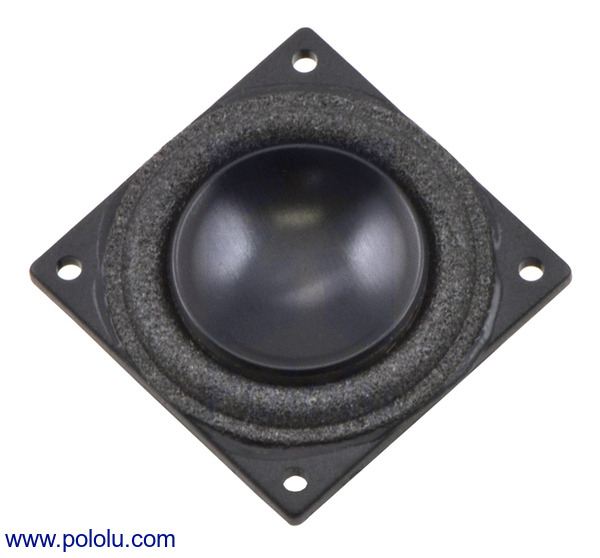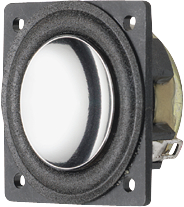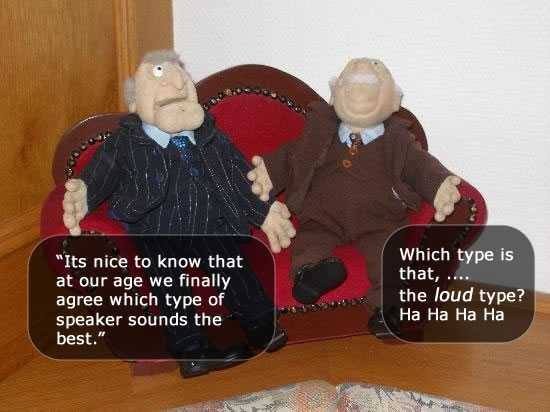Polar plots
Getting back to this important point. I am certainly confused. Tho I "think" that I saw horizontal polar plots in Keele's Powerpoint presentation, I don't see them in the AES paper. I didn't get a CD with a copy of the Powerpoint.
Has anyone else seen the horizontal polar plots? I don't remember a significant shift in tonal balance off axis, but would love to see plots. Thanks
You and I both know that the CBT is not constant directivity in the horizontal direction, its directivity must change with frequency. It seems that there is a great deal of confusion on this point.
Getting back to this important point. I am certainly confused. Tho I "think" that I saw horizontal polar plots in Keele's Powerpoint presentation, I don't see them in the AES paper. I didn't get a CD with a copy of the Powerpoint.
Has anyone else seen the horizontal polar plots? I don't remember a significant shift in tonal balance off axis, but would love to see plots. Thanks
...my third CBT paper titled “Full-Sphere Sound Field of Constant-Beamwidth Transducer (CBT) Loudspeaker Line Arrays” available from my web site (http://www.xlrtechs.com/dbkeele.com/PDF2/Keele (200303 AES Preprint) - CBT Paper3.pdf).
I think this is the paper cited. The link above did not work.
Paper 3
I have suggested on another site that those DIYers interested in experimenting with CBT might rationally begin with the simpler and significantly more modest group delay steered 50LA design:
http://www.jblpro.com/catalog/support/getfile.aspx?doctype=3&docid=1402
For which complete documentation is available here:
http://www.jblproservice.com/pdf/CBT/CBT 50LA-WH.pdf
Am I way off base with this? If not, what driver might be appropriately used?
http://www.jblpro.com/catalog/support/getfile.aspx?doctype=3&docid=1402
For which complete documentation is available here:
http://www.jblproservice.com/pdf/CBT/CBT 50LA-WH.pdf
Am I way off base with this? If not, what driver might be appropriately used?
Last edited:
I have suggested on another site that those DIYers interested in experimenting with CBT might rationally begin with the simpler and significantly more modest group delay steered 50LA design:
DIYers could build their own shaded array with any favorite full range driver. My paper shows a 16 element short line that performed pretty well, if not quite to the CBT standards. It was split into 4 electrical groups with relative levels of 0dB, -1dB, -3dB and -10dB. These would apply respectively to the center 4 elements, the 2 above and below the central 4, the next two above and below them, and the final two outer pairs. Resistive padding could achieve the level drop if you confirm the frequency response remains fairly flat.
Laid sideways the element strengths are like this:
-10 -10 -3 -3 -1 -1 0 0 0 0 -1 -1 -3 -3 -10 -10 (dB)
If your lines go floor to ceiling you don't need to do any of this. It is only for the short to medium lines that the arrays become very variable in vertical performance.
David
"the" tweeters, maybe?
Buy a case, or 2. They come in quantity 2000.
I thought the surrounds on the speakers in Dayton were rubber.
This was posted by "darno" over on the PE Tech Talk forum:

Buy a case, or 2. They come in quantity 2000.
I thought the surrounds on the speakers in Dayton were rubber.
This was posted by "darno" over on the PE Tech Talk forum:

/http://www.jlworld.com/
SoniCrest
model HSB1818A-4 www.jlworld.com/products/spdpn/HSB1818A-4/$FILE/HSB1818A-4.pdf
model HSB18A www.jlworld.com/products/spdpn/HSB18A/$FILE/HSB18A.pdf
also interesting model HSB1425A www.jlworld.com/products/spdpn/HSB1425A/$FILE/HSB1425A.pdf
another site
Pololu - 18mm Speaker: 4 Ohm, 2.0 W
Aurasound also lists a model NDW1425-827-4B
Last edited:
Buy a case, or 2. They come in quantity 2000.
Drivers like that have a great packing factor when mounted end to end. That helps push off the lobing frequency.
David
Hi,
This might be a driver option:
Rated power handling 3 W
Impedance 8 Ω
Mean sound pressure 76 dB
Transmission range 120…20000 Hz
2.73€ each in 100pc lots.
http://www.diyaudio.com/forums/full-range/165942-small-32mm-wide-ranger-veco-32kc08.html#post2169012
https://www1.elfa.se/data1/wwwroot/assets/datasheets/03020757_1.pdf

- Elias
This might be a driver option:
Rated power handling 3 W
Impedance 8 Ω
Mean sound pressure 76 dB
Transmission range 120…20000 Hz
2.73€ each in 100pc lots.
http://www.diyaudio.com/forums/full-range/165942-small-32mm-wide-ranger-veco-32kc08.html#post2169012
https://www1.elfa.se/data1/wwwroot/assets/datasheets/03020757_1.pdf

- Elias
Last edited:
Hello David,
You are right.
However, since most of the conclusions in psychoacoustic studies are done based on listener preference comparing a loudspeaker against another loudspeaker, and not a loudspeaker against reality, And since almost all the loudspeakers used are conventional monopole boxes, I really wish to see a study where line arrays are used.
After all, for example in case of early reflections, line arrays provide completely different pattern in temporal, magnitude and spatial domain than a conventional monopole box, it can be questionable if the conclusions based on available listener preference are valid.
Myself, I've been using dipole line array for several years. It's a straight array, no tapering, no delay, no curving, simple as it can be. I'm very pleased in it's behaviour in the normal living room acoustics. It delivers me more of the recording venue acoustics and less of the listening room.
- Elias
You are right.
However, since most of the conclusions in psychoacoustic studies are done based on listener preference comparing a loudspeaker against another loudspeaker, and not a loudspeaker against reality, And since almost all the loudspeakers used are conventional monopole boxes, I really wish to see a study where line arrays are used.
After all, for example in case of early reflections, line arrays provide completely different pattern in temporal, magnitude and spatial domain than a conventional monopole box, it can be questionable if the conclusions based on available listener preference are valid.
Myself, I've been using dipole line array for several years. It's a straight array, no tapering, no delay, no curving, simple as it can be. I'm very pleased in it's behaviour in the normal living room acoustics. It delivers me more of the recording venue acoustics and less of the listening room.
- Elias
Most studies on the subject aren't so specific as to evaluate a particular speaker in a domestic room. Rather, there have been many good papers on the audibility of reflections versus all the variables that might occur. Toole's book gives a great summary on both what he and Sean Olive found, and also others such as Ando, Devatier, and Bech.
Researchers have studied what level of reflection is just detectable, what level causes image shift, what level cause audible timbre modification and what level is perceived as a distinct echo. Generally these thresholds are measured vs. arrival time. Direction of arrival is also key. The test noise is important as well (speech, pink noise, impulses).
Knowing all this you could then infer the performance of any specific radiation pattern and room.
The most interesting results are about the difference in impression that lateral and vertical reflections gave. Although the detection thresholds were not too far off, Olive and Toole found "the lateral reflection generating much more of a sensation of spaciousness at levels just above threshold, whereas the vertical reflection, on the median plane, was apparent more as an effect on timbre, with a slight amount of high-frequency spatial diffuseness."* Bech found similarly that the room reflection most likely to be audible was the floor bounce.
The conclusion seems to be that narrower vertical dispersion and very wide lateral dispersion are a good thing. They will reduce the coloration effects of floor ceiling bounces while maximising the lateral spaciousness. The CBT array should be very good for this.
Note that the CBT using the floor is not a "floor bounce' per se, but a mirrored reflection of the second half. Tiled or carpeted, the floor is very reflective for low frequencies and more reflective than you think for high frequencies.
I have looked with interest at the CBT for possible theater use. I don't know about the output capibilities, but the evenness of coverage across a seating area would be great.
Regarding uncontrolled lateral directivity, nothing would stop JBL from using CD contours for achieving any desired lateral directivity, or a 2D array as Audiopioneer suggested. These are primarily a commercial sound product and wide lateral/narrow vertical are the desired dispersions (typical house of worship application).
David Smith
*The Detection of Reflections in Typical Rooms
Hello David,
You are right.
However, since most of the conclusions in psychoacoustic studies are done based on listener preference comparing a loudspeaker against another loudspeaker, and not a loudspeaker against reality, And since almost all the loudspeakers used are conventional monopole boxes, I really wish to see a study where line arrays are used.
After all, for example in case of early reflections, line arrays provide completely different pattern in temporal, magnitude and spatial domain than a conventional monopole box, it can be questionable if the conclusions based on available listener preference are valid.
Myself, I've been using dipole line array for several years. It's a straight array, no tapering, no delay, no curving, simple as it can be. I'm very pleased in it's behaviour in the normal living room acoustics. It delivers me more of the recording venue acoustics and less of the listening room.
- Elias
Look up the AES papers of Salmi. He was exploring the interaction of a loudspeaker with the room and how it impacts our perception of frequency response. He found that early boundary reflections were objectionable and advocated greater vertical directivity. He ended up designing a short line array to reduce the floor bounce.
You will like his conclusions.
David Smith
Don has measured earlier GPCBT prototypes over carpet and found that they work very well, but since this question is appearing often, we plan to measure the speaker on a hard flat surface and then insert a large piece of carpet in front of the speaker and repeat the measurement. We will post these results also.
-mk
A "piece of carpet" over a hard floor will not be sufficient to simulate many home conditions, imo. PM me to continue that discussion offline
(Don - great to see you here!).
_-_-
@Don & speaker Dave,
Again Don, fabulous to have you on here!
Speakerdave, i still don't fully understand your design - you made a few references that didn't (to me) seem clear, but it's just a "standard" CBT then?
Don, (and David) when I look at the nice color images showing the vertical "strata" for radiation in Don's paper (the first referenced one here) I think I see that while the levels in the listening plane are equalized nicely that there is a substantial amount of radiation that rises above the plane of the top of the speaker.
What I am saying is that while this may not be an issue, I have some concerns about it (even if it is attenuated) in the home environment where the ceiling is not a long distance away (as it is in a typical medium to large venue) or in a testing facility with high ceiling heights. I am not suggesting that it is a fatal flaw, just something that the figures in Don's paper illustrates, and that is worthy of some discussion...
_-_-bear
Again Don, fabulous to have you on here!
Speakerdave, i still don't fully understand your design - you made a few references that didn't (to me) seem clear, but it's just a "standard" CBT then?
Don, (and David) when I look at the nice color images showing the vertical "strata" for radiation in Don's paper (the first referenced one here) I think I see that while the levels in the listening plane are equalized nicely that there is a substantial amount of radiation that rises above the plane of the top of the speaker.
What I am saying is that while this may not be an issue, I have some concerns about it (even if it is attenuated) in the home environment where the ceiling is not a long distance away (as it is in a typical medium to large venue) or in a testing facility with high ceiling heights. I am not suggesting that it is a fatal flaw, just something that the figures in Don's paper illustrates, and that is worthy of some discussion...
_-_-bear
Well in the hotel meeting room the ceiling was somewhat high, maybe 12'. But there was a wide soffit at 8'. Don's array was at the inner edge of the soffit. From the pattern charts, I don't think much if any energy was hitting the soffit. It was probably hitting the ceiling 9 or ten feet away. Just FWIW.
@bear,
Yes I agree that the carpet over a hard floor will not simulate a living room, however it will be a first order estimate of carpet's impact on the floor's reflection and if/how it affects the speakers frequency response. I think it is best to take one step at a time, so after we get past this test we can move to a more representative room that approximates a normal living space.
-mk
Yes I agree that the carpet over a hard floor will not simulate a living room, however it will be a first order estimate of carpet's impact on the floor's reflection and if/how it affects the speakers frequency response. I think it is best to take one step at a time, so after we get past this test we can move to a more representative room that approximates a normal living space.
-mk
Last edited:
You might download and read the 4 part paper I attached a couple of pages back. It includes everything I know on the subject.@Don & speaker Dave,
Speakerdave, i still don't fully understand your design - you made a few references that didn't (to me) seem clear, but it's just a "standard" CBT then?
Don, (and David) when I look at the nice color images showing the vertical "strata" for radiation in Don's paper (the first referenced one here) I think I see that while the levels in the listening plane are equalized nicely that there is a substantial amount of radiation that rises above the plane of the top of the speaker.
_-_-bear
While there may be radiation above the top of the speaker, it is considerably less with any line array than it would be from a conventional non-arrayed system.
David
Is that Geddes (on left) and Linkwitz belittling the need for a loudspeaker to play loud?

I know my Dad likes to brag about being an "old" guy, but at least he doesn't need hearing aids.... oh but maybe that would be great, cause you know he'll try to utilize the miniature drivers somehow!
It may be that I do not understand what I am seeing in Don's paper. But I am comparing the Legendre shaded 50 driver array figs 62-5 with 41-3 for the straight line source.
I seem to see energy going up vs. energy not going up??
So, perhaps I'd prefer a taller speaker??
No matter what, the "shaded array" is a neat idea.
@ Dave, i think i read your pdf, and if your speaker is explained fully there, I'm as yet unclear - but this seems to be a trend with me??
I seem to recall the McIntosh line source speakers - too bad the technology wasn't really "disclosed" in the marketing... although perhaps I am thinking of much earlier speakers from them??
_-_-bear
I seem to see energy going up vs. energy not going up??
So, perhaps I'd prefer a taller speaker??
No matter what, the "shaded array" is a neat idea.
@ Dave, i think i read your pdf, and if your speaker is explained fully there, I'm as yet unclear - but this seems to be a trend with me??
I seem to recall the McIntosh line source speakers - too bad the technology wasn't really "disclosed" in the marketing... although perhaps I am thinking of much earlier speakers from them??
_-_-bear
- Home
- Loudspeakers
- Multi-Way
- Constant Beam Width Transducers line arrays
